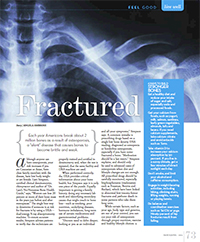 Each year Americans break about two million bones as a result of osteoporosis, a “silent” disease that causes bones to become brittle and weak.
Each year Americans break about two million bones as a result of osteoporosis, a “silent” disease that causes bones to become brittle and weak.
Although anyone can have osteoporosis, your risk increases if you are Caucasian or Asian, have close family members with the disease, low body weight or are female.
“Women can lose 20 percent or more of their bone mass in the years just before and after menopause,” says Lani Simpson, a certified clinical densitometrist, chiropractor and author of “Dr. Lani’s No-Nonsense Bone Health Guide.”
The single best way to determine if someone is at risk for fractures is by using a DXA – dual-energy X-ray absorptiometry machine. To ensure accurate results, Simpson advises patients to verify that the technicians are properly trained and certified in densitometry, and when the test is repeated, that the same facility and DXA machine is used.
When performed correctly, the DXA provides critical information about your bone health, but Simpson says it is only one piece of the puzzle. Equally important is getting a family history, doing any necessary lab work and identifying secondary causes that might result in bone loss – such as smoking, poor nutrition, underlying diseases, hormone imbalances, long-term use of certain medications and gastrointestinal problems.
“Doctors need to delve deeper, looking at you as an individual and all your symptoms,” says Simpson. A common mistake is prescribing drugs based on a single low bone density DXA reading, diagnosed as osteopenia or borderline osteoporosis, especially if you have never fractured a bone.
“Medication should be a last resort,” explains Simpson, and should only be used in advanced cases of osteoporosis when diet and lifestyle changes are not enough. All prescribed drugs should be carefully monitored, especially bisphosphonates (tradenames such as Fosamax, Boniva and Reclast), which have been linked to abnormal low-trauma femur fractures and jaw bone death in some patients who take them long term.
While certain factors, such as your age, body type and genetics, are out of your control, you can cut your risk of osteoporosis through proper nutrition, exercise and healthy lifestyle choices.
6 Ways to Build Stronger Bones
- Eat a healthy diet and reduce your intake of sugar and salt, especially soda and processed foods.
- Get your calcium from foods, such as yogurt, milk, salmon, sardines, leafy green vegetables, almonds, tofu and beans. If you need calcium supplements, take calcium citrate and avoid antacids such as Tums.
- Take Vitamin D to increase your calcium absorption by 50 percent. If you live in a sunny climate, get a few minutes of direct sunlight each day.
- Don’t smoke and limit your alcohol and caffeine consumption.
- Engage in weight-bearing activities, including hiking, climbing stairs, lifting weights, running or playing tennis.
- Do balance and coordination exercises such as Tai Chi or yoga. Ninety percent of hip fractures result from falling.